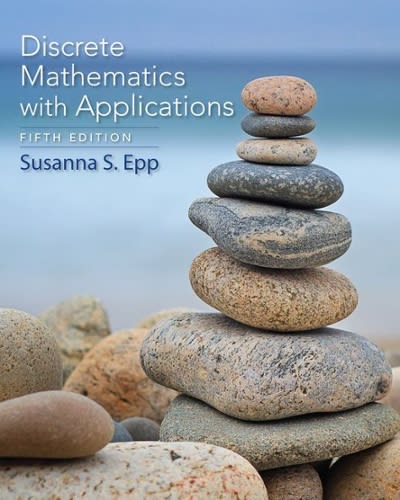Question
1. The generations are distinct (making this a discrete system). 2. Each rabbit pair will be ready to reproduce at the end of the second
1. The generations are distinct (making this a discrete system).
2. Each rabbit pair will be ready to reproduce at the end of the second generation (born in Generation 1, develop in Generation 2, first offspring in Generation 3).
3. Each pair of mature rabbits has one pair of offspring in each generation.
4. Rabbits will live forever. The model does not assume that there is a life expectancy for rabbits.
5. Rabbits will continue to have offspring forever. The model does not assume that rabbits will stop having offspring after a certain number of generations.
Task D
Now go back to the original model from Part 1 and change assumption 4. Let's assume that rabbits die after 5 generations instead of living forever. Use another rabbit model to answer the question "In which generation does the rabbit population reach a level of 100,000 pairs of rabbits?" under this modified assumption. Be sure to give an algorithmic description of this model in terms of a recurrence relation and also build your model into a spreadsheet.
Additional Information:
I'm having trouble finding an appropriate equation for Task C in Excel. Any help in that direction would great! So far I have, 1,1,2,3,5,7 I know that the rabbits only live to the fifth generation which is how I got 7 to account for the death of the generation 4 rabbits but I'm not sure where to go next.
Original Sequence: 1, 1, 2, 3, 5, 8, 13, 21, 34...(Fibonacci)
1. In Generation 1, we start off with one pair of rabbits.
2. In Generation 2, this pair of rabbits matures.
3. In Generation 3, this original pair of rabbits gives birth to another pair of rabbits.
4. In Generation 4, the original pair gives birth to their second pair and the first offspring of the original pair also matures
1. The rabbits in the first row are the original newborn pair in Generation 1, mature in Generation 2, and have offspring in Generations 3, 4, 5, and 6.
2. The rabbits in the second row are the first pair of offspring of the original rabbits. They are a newborn pair in Generation 3, mature in Generation 4, and have offspring in Generations 5 and 6.
3. The rabbits in the third row are the first pair of offspring of the first pair of offspring of the original. They are a newborn pair in Generation 5 and are not yet mature enough to have any offspring by the end of this diagram.
Step by Step Solution
There are 3 Steps involved in it
Step: 1

Get Instant Access to Expert-Tailored Solutions
See step-by-step solutions with expert insights and AI powered tools for academic success
Step: 2

Step: 3

Ace Your Homework with AI
Get the answers you need in no time with our AI-driven, step-by-step assistance
Get Started


